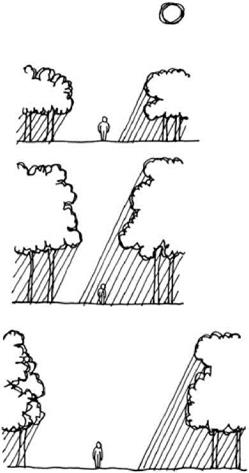Any site that contains a picnicking area, whether tables, benches or fireplaces are installed or not, should be laid out to give a variety of spaces by using the structure of landform, vegetation or whatever is available. In forests or at the forest edge spaces can be created that offer a range of shelter, open views, sunshine, shade, large spaces for big families, small spaces for couples and so on. The landform can be used to identify the potential for making spaces and clearings that take advantage of the variety of the sites.
The area should be developed with a hierarchy of spaces of different scales. The first task is to consider the overall extent of the picnic area and the main pedestrian circulation likely to be developed from the car park, toilets and other features such as water edges, viewpoints and trail starts within the immediate vicinity. There will be obvious entry and exit points, which will become important lines of access (desire lines) into the area. Spaces within which picnicking can be set should be developed in relation to these circulation routes and the landform, vegetation and site variety described above. Some locations should maintain views of the car park for those who feel safest keeping their car in view, or who cannot or do not wish to carry a great deal of equipment for any distance.
This large layout can be subdivided into different-sized smaller spaces for one or more picnic units. The orientation of spaces should reflect the micro-site features, giving warm, sunny aspects to some and greater shade to others. This will
|
In wooded areas, tree growth affects the scale of spaces and the degree to which the sun reaches the ground. Management over time might include gradually enlarging open glades so as to maintain their sunny nature. |
depend on the climate. In Britain, or other cool, moist climates, sunshine in summer is at a premium, and so suntrap sites are much appreciated. However, in the Arizona desert, shade is essential, and this will be a deciding factor.
In enclosed landscapes such as forest glades, the spaces can be subdivided with other trees and shrubs in clumps, groups or promontories from the edge. In open landscapes the landform, if there is any, can be reinforced with shrubs, if trees are not appropriate. Where a particular feature such as a water’s edge occurs, then this provides a lure. Picnic spaces should be spread along the edge at wide intervals.
The number of picnic places required will depend on the amount of parking to be provided and the way in which the site serves the main functions for the area. If the main purpose of the site is to stop and picnic, the number of places should be roughly the same as the number of car spaces, although not all need be equipped with furniture. At other sites many people might hike or sail and not wish to picnic, thus considerably reducing the number of places needed.
As well as creating a variety of spaces for picnicking, there will be a need to maintain and manage them over time. There are many examples where an attractive sunny space was created amongst trees that subsequently grew and shaded the space. Hence trees and shrubs may have to be cut to maintain the size of the space and its microclimate as well as the access routes or paths amongst the area. Grass cutting may also be required several times a year during the growing season.




